Boerhavia intermedia
|
|
|
|
Family: Nyctaginaceae
fivewing spiderling, more...spiderling, five-wing spiderling, Jone's boerhavia (es: mochis)
[Boerhavia erecta var. intermedia (M.E. Jones) Kearney & Peebles, moreBoerhavia universitatis Standl.] |
Herbs, annual; taproot tapered, soft or ± woody. Stems usually erect or ascending, occasionally decumbent, moderately or profusely branched primarily distally, 2-6 (-8) dm, minutely puberulent with bent hairs basally, glabrous or minutely puberulent distally. Leaves mostly in basal 1/2 of plant; larger leaves with petiole 7-25 mm, blade broadly ovate or oval to lanceolate, 20-45 × 7-16 mm (distal leaves smaller, sometimes longer, proportionately narrower), adaxial surface usually glabrous, occasionally glandular-puberulent, often minutely punctate, abaxial surface paler than adaxial, glabrous or glabrate, usually punctate with small patches of reddish or brownish cells, base round, obtuse, or truncate, margins entire or slightly sinuate, apex acute, obtuse, or round. Inflorescences terminal, forked ca. 3-6 times ± evenly (or clearly unevenly), diffuse, usually with sticky internodal bands; branches strongly ascending, terminating in umbels or flowers borne singly, occasionally subumbellate (all pedicels not attaching at same point), rarely irregularly compound umbels. Flowers: pedicel 0.5-3.2 mm; bracts at base of perianth quickly deciduous, (1-)2, narrowly lance-acuminate, 0.5-1 mm; perianth whitish to pale pink or purplish, campanulate distal to constriction, 0.7-1.2[-2] mm; stamens 2-3, included or barely exserted. Fruits 1-15 per cluster, straw colored or gray-brown, obconic, broadly low conic, 2-2.8(-3.2) × 0.7-1.3 mm (l/w: 1.7-3.2), apex nearly truncate, glabrous; ribs (4-)5, acute, slightly rugose or undulate near sulci; sulci 0.2-1 times as wide as base of ribs, coarsely transversely rugose, smooth or very faintly papillate. 2n = 52, ca. 54. Flowering summer-late fall. Sandy or gravelly areas in deserts and arid grasslands, disturbed areas; [0-]100-1700 m; Ariz., Calif., Nev., N.Mex., Tex.; Mexico (Baja California, Baja California Sur, Chihuahua, Coahuila, Durango, Sonora). Boerhavia intermedia is a wide-ranging and variable species of the arid areas of southwestern North America. Ordinarily, the terminal inflorescence is an umbel of at least a few flowers. Plants with few-flowered umbels often have only one flower at some of the terminal inflorescences. Plants with predominantly or entirely one-flowered terminal inflorescences occasionally occur in the eastern part of the range. To the west, and especially on the Coloradan portion of the Sonoran Desert and on the Baja California peninsula, plants with one-flowered terminal inflorescences are more frequent, and even though those have five-ribbed fruits, they often have been identified as B. triquetra. In that region, such plants may have proportionately broader fruits as the ribs become more winglike. Some plants in southern California bear a few fruits with four angles, and in this respect are intermediate to B. triquetra.
FNA 2003, Wiggins 1964, Kearney and Peebles 1969, McDougall 1973 Duration: Annual Nativity: Native Lifeform: Forb/Herb General: Annual herb, 20-60 cm tall, from a taproot; stems erect or ascending to occasionally decumbent, moderately or profusely branched primarily near top; herbage covered with bent, minute hairs, especially near base of plant. Leaves: Opposite, on petioles shorter than the blades, with the leaves concentrated toward the lower half of the plant; blades thick and fleshy, 4-5 cm long and 1-5 cm wide, broadly oblong to ovate-lanceolate, with smooth or slightly sinuate margins; leaf surfaces glaucous, especially the undersides; both surfaces often brown-punctate. Flowers: Pink, in umbellate clusters of a few flowers, the clusters arranged in diffuse panicles with ascending branches that fork 3-6 times, with sticky bands on the branches and pedicels; sepals appearing petal-like, about 1 mm long, whitish to pale pink or purplish, and fused into a bell-shape; petals absent. Fruits: Achenes straw-colored or gray-brown, 2-3 mm long and 1 mm wide, obconic and flattened at the tip, glabrous. Ecology: Found in sandy soils, from 1,000-4,500 ft (305-1372 m); flowers July-September. Distribution: s CA, s NV, AZ, NM, s TX; south to n MEX. Notes: A wide-ranging and variable species. Usually the inflorescence is composed of small umbels of at least a few flowers, with equal-lengthed pedicels emerging from a single point on on the branchlet; however, in the lower deserts of the Southwest, flowers at the branch tips are often solitary rather than clustered. B. erects is quite similar but that species often tends to be taller, over 0.5 m tall, and if you look closely you'll see that the clusters of flowers are not truly umbellate, with pedicels not all the same length and one or twow in each cluster emerging slightly below the others. The species intergrades with both B. erects and B. triquetra in different parts of its range. Ethnobotany: The species serves as host for a moth that was eaten in the larval stage by the O'odham tribes. Etymology: Boerhavia is named to honor Dutch botanist Hermann Boerhaave (1663-1738); intermedia means in between. Synonyms: Boerhavia erecta var. intermedia, Boerhavia triquetra var. intermedia Editor: SBuckley 2010, FSCoburn 2015, AHazelton 2017 |
|
|
|























































































